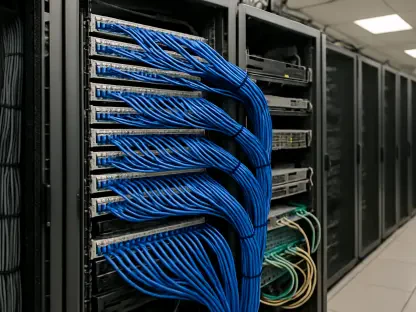The landscape of data centers is on the brink of a paradigm shift as traditional terrestrial centers encounter severe energy and capacity constraints. In response, innovations like Lumen Orbit’s proposal to deploy data centers in space are gaining traction. This novel approach, supported by Nvidia and Y Combinator, aims to address the burgeoning demands from next-gen artificial intelligence (AI) and potentially solve some of the most pressing challenges faced by traditional data centers today.
The Rising Energy Demands of AI and Challenges on Earth
Terrestrial data centers are battling significant limitations as they strive to keep pace with the rapid advancements in AI. The impending necessity for multi-gigawatt (GW) capacity by 2027 to efficiently train large language models (LLMs) starkly contrasts with the current capabilities of terrestrial data centers, which generally top out at around 100 megawatts (MW), with some exceptions reaching 1GW. However, scaling beyond these numbers on Earth is fraught with challenges.
Firstly, energy availability is a monumental issue. Terrestrial solar farms in the US, for instance, have a median capacity factor of only 24%, with temperate regions faring even worse, recording under 10%. Additionally, constructing large-scale projects often takes over a decade in Western regions due to intricate permitting procedures and stringent environmental regulations. These limitations highlight the urgency for innovative solutions that can accommodate the growing energy needs without the protracted timelines associated with terrestrial projects.
Furthermore, the energy demands of AI continue to surge, placing unprecedented strain on existing infrastructure. The complexity of training large language models necessitates vast computational power, translating to higher energy consumption. Traditional data centers, struggling to meet these escalating demands, face significant sustainability concerns. Earth-based solutions often entail extensive land use and environmental trade-offs, exacerbating the already critical situation. In this context, the exploration of extraterrestrial alternatives becomes not only appealing but essential to maintaining the momentum of AI developments.
Orbital Data Centers: A Viability Assessment
Lumen Orbit emphatically argues that space-based data centers are both feasible and economically viable. In their recent whitepaper, the company presents a compelling case for why orbital data centers are an essential infrastructural progression needed to unlock AI’s full potential—a pivotal technology of our era. The advantages of space-based data centers are primarily hinged on the availability of abundant and uninterrupted solar energy in space, along with passive cooling methods not contingent on day/night cycles or weather conditions. These factors collectively promise significant reductions in operational costs.
Projections estimate a 20-fold decrease in expenses over a decade compared to their terrestrial counterparts, positioning these orbital centers as a promising economic alternative. The uninterrupted solar energy available in space eliminates the reliability issues plaguing terrestrial solar farms, ensuring a steady power supply crucial for AI operations. Moreover, the passive cooling benefits of space, devoid of atmospheric variability, further enhance the feasibility of this ambitious project. By harnessing these extraterrestrial advantages, Lumen Orbit envisions a cost-efficient, scalable solution that could redefine the data center industry.
Additionally, the economic appeal is bolstered by the minimal need for extensive terrestrial infrastructure and regulatory navigation. Deploying data centers in space circumvents the lengthy permitting processes and environmental stipulations that often delay large-scale terrestrial projects. This streamlined deployment allows for rapid scalability, essential for meeting the accelerating demands of AI. The prospect of dramatically reduced marginal energy costs in space adds to the financial viability, positioning orbital data centers as a forward-thinking, strategic initiative poised to revolutionize the computational landscape.
Technological Innovations and Deployment Timeline
Lumen Orbit is not just planning but executing their vision with tangible milestones. The company aims to launch a demonstrator satellite by May 2025, a timeline that underscores their technological preparedness. These orbital data centers will reportedly operate with GPUs 100 times more powerful than any previously deployed in space, capitalizing on advanced hardware to meet AI’s rigorous demands. Such technological advancements signify a pivotal step in addressing the computational intensity of AI, leveraging cutting-edge hardware to sustain the burgeoning needs of large language models and other AI frameworks.
The design of these data centers features sprawling solar arrays, each measuring approximately 4 KM by 4 KM, employing thin-film cells with cooling loops. A modular design approach is adopted, allowing individual components to be independently docked or undocked, ensuring scalability and maintenance efficiency. These innovations aim to extend the operational life of the data centers to at least 10 years without major overhauls, further enhancing their economic viability. The expansive solar arrays maximize energy capture, while the modular setup facilitates seamless upgrades and repairs, essential for long-term sustainability.
Moreover, the focus on minimal moving parts underscores a commitment to reliability, a crucial factor in the harsh environment of space. By reducing mechanical complexity, Lumen Orbit aims to mitigate failure risks, ensuring consistent operation over extended periods. The innovative design, coupled with advanced GPU capabilities, positions these space-based data centers as a robust solution capable of supporting the sophisticated demands of AI. With a strategic deployment timeline and a focus on technological excellence, Lumen Orbit is poised to transform the data center paradigm, pushing the boundaries of what is achievable in space-based infrastructure.
Overcoming Orbital Challenges
While the potential of space-based data centers is immense, several critical challenges accompany their deployment. Space debris, radiation exposure, aerodynamic drag, and network latency are significant considerations that necessitate robust solutions. The presence of space debris poses a tangible risk to orbital hardware, requiring sophisticated tracking and mitigation strategies to ensure operational safety. Radiation exposure, exacerbated by the absence of atmospheric shielding, demands advanced protective measures to safeguard sensitive electronic components and ensure their longevity.
To ensure uninterrupted solar illumination, these centers must maintain a low-Earth, dawn-dusk sun-synchronous orbit, positioning them in perpetual sunlight. This orbit minimizes the impact of aerodynamic drag and maximizes exposure to solar energy, crucial for uninterrupted data center operations. The strategic orbit selection not only enhances energy efficiency but also addresses thermal regulation challenges, leveraging continuous solar exposure for passive cooling.
Furthermore, the issue of network latency, inherent in space-based operations, necessitates the development of advanced communication protocols to ensure seamless data transfer between orbital centers and terrestrial networks. By addressing these multifaceted challenges through innovative engineering and strategic planning, Lumen Orbit aims to harness the full potential of space-based data centers, establishing a new frontier in computational infrastructure.
AI-Centric Infrastructure and Economic Incentives
The shift towards AI-centric infrastructure is a clear trend. The anticipation of multi-GW clusters reflects the escalating computational demands driven by large AI models and LLMs, necessitating robust, scalable, and sustainable solutions beyond terrestrial confines. Space-based data centers, leveraging extraterrestrial advantages, offer a promising pathway to meet these expanding needs. The inherent scalability of orbital infrastructure aligns perfectly with the dynamic nature of AI advancements, providing a future-ready solution capable of evolving alongside technological progress.
Economic and environmental incentives further bolster the argument for space-based data centers. Leveraging the abundant extraterrestrial solar energy and eliminating the need for batteries, Lumen Orbit envisions significantly lower marginal energy costs. This, coupled with reduced physical and permitting constraints, makes space-centric deployment an attractive alternative. The environmental benefits are also substantial, with the potential to minimize the ecological footprint associated with large-scale terrestrial projects. By shifting energy-intensive operations to space, Lumen Orbit aims to alleviate some of the environmental pressures on Earth, contributing to broader sustainability goals.
Moreover, the economic viability of space-based data centers is underscored by the potential for rapid scalability without the protracted development timelines typical of terrestrial projects. This agility is crucial in an era of exponential AI growth, ensuring infrastructure keeps pace with technological advancements. The promise of reduced operational costs, paired with the environmental advantages of space deployment, positions Lumen Orbit’s initiative as a forward-thinking solution poised to redefine the data center industry.
Exploring Other Frontiers and Innovations
Lumen Orbit is not alone in exploring celestial solutions. Other companies like Lonestar Data Holdings are contemplating data centers on the moon, broadening the spectrum of extraterrestrial real estate. This lunar approach introduces a new dimension to the space-based data center landscape, potentially leveraging the moon’s unique environment for sustainable operations. Concurrently, firms like Axiom Space, Kepler Space, and Skyloom are also innovating in the domain of space-based data handling. These initiatives reflect a growing consensus within the industry on the viability and potential of extraterrestrial data centers, each exploring different aspects of the space environment.
Terrestrial-based alternatives continue to evolve as well. Noteworthy endeavors include Microsoft’s testing of underwater data centers, alongside similar projects by Subsea Cloud and Beijing Highlander Digital Technology. These underwater explorations aim to leverage the cooling benefits of aquatic environments, presenting a novel solution to the thermal management challenges of traditional data centers. While distinct from the space-based approach, these initiatives highlight the broader industry pursuit of innovative solutions to data center constraints, whether terrestrial or extraterrestrial.
This multifaceted exploration underscores a collective industry commitment to overcoming the limitations of traditional data centers. By diversifying the approaches—whether through space-based, lunar, or underwater innovations—the industry is actively seeking sustainable, scalable solutions to support the ever-growing demands of modern AI and computational workloads. The convergence of these diverse initiatives signifies a transformative shift in the data center landscape, driven by the pursuit of efficiency, sustainability, and technological excellence.
The Future of Data Centers: A Holistic Industry Pursuit
The data center landscape is on the verge of significant transformation as traditional land-based facilities grapple with severe energy and capacity limits. In response, groundbreaking solutions like Lumen Orbit’s plan to deploy data centers in space are rapidly gaining momentum. Supported by tech giants Nvidia and startup incubator Y Combinator, this innovative concept aims to tackle the growing needs of next-generation artificial intelligence (AI) while also addressing some of the most critical challenges facing current data centers.
Traditional data centers consume vast amounts of energy and are running out of space, leading to inefficiencies and increased costs. The move to space-based data centers could alleviate these issues by leveraging the limitless expanse and potentially tapping into solar energy, reducing the carbon footprint associated with terrestrial facilities. This approach not only promises enhanced performance and scalability but also provides a sustainable solution in an era where data consumption is skyrocketing. The support from industry leaders underscores the feasibility and potential impact of Lumen Orbit’s visionary project, marking a new frontier for data management and AI advancement.









